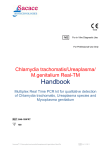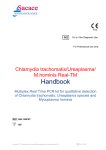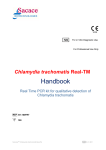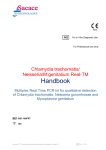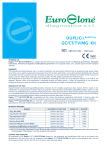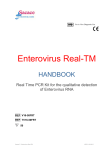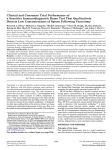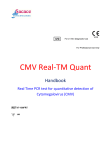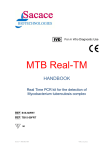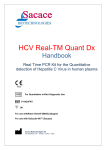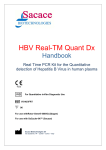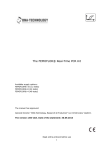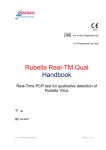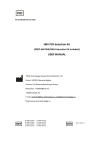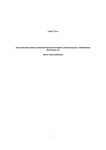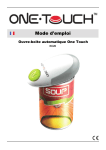Download Chlamydia Ureaplasma M.genitalium M.hominis Real
Transcript
For in Vitro Diagnostic Use For Professional Use Only Сhlamydia trachomatis/Ureaplasma/ M.genitalium/M.hominis Real-TM Handbook Multiplex Real Time PCR kit for qualitative detection of Chlamydia trachomatis, Ureaplasma species, Mycoplasma genitalium and hominis REF B60-100FRT 100 Sacace™ Сhlamydia trachomatis/Ureaplasma/M.genitalium Real-TM VER 14.11.2011 NAME Сhlamydia trachomatis/Ureaplasma/M.genitalium/M.hominis Real-TM INTRODUCTION STDs (sexually transmitted diseases) refer to a variety of bacterial, viral and parasitic infections that are acquired through sexual activity. Some STDs, such as syphilis and gonorrhea, have been known for centuries — while others, such as HIV, have been identified only in the past few decades. STDs are caused by more than 25 infectious organisms. As more organisms are identified, the number of STDs continues to expand. Common STDs include: chlamydia, gonorrhea, herpes, HIV, HPV, syphilis, gardnerella and trichomoniasis. The Chlamydia trachomatis is nonmotile, gram-negative bacterial pathogen and is the most common sexually transmitted bacterial agent. The prevalence of C. trachomatis infection in sexually active adolescent women, the population considered most at risk, generally exceeds 10%, and in some adolescent and STD clinic populations of women, the prevalence can reach 40%. The prevalence of C. trachomatis infection ranges from 4 to 10% in asymptomatic men and from 15 to 20% in men attending STD clinics. Chlamydial infections in newborns occur as a result of perinatal exposure; approximately 65% of babies born from infected mothers become infected during vaginal delivery. The development of tests based on nucleic acid amplification technology has been the most important advance in the field of STD diagnosis. Because nucleic acid amplification is exquisitely sensitive and highly specific, it offers the opportunity to use noninvasive sampling techniques to screen for infections in asymptomatic individuals who would not ordinarily seek clinical care. INTENDED USE Сhlamydia trachomatis/Ureaplasma/M.genitalium/M.hominis Real-TM PCR kit is an in vitro nucleic acid amplification test for multiplex detection of Chlamydia trachomatis, Ureaplasma (parvum and urealyticum), Mycoplasma genitalium and Mycoplasma hominis DNA in clinical materials (urogenital, rectal and pharyngeal swabs; conjunctival discharge; prostate gland secretion; and urine samples) by using real-time hybridization-fluorescence detection. The results of PCR analysis are taken into account in complex diagnostics of disease. Sacace™ Сhlamydia trachomatis/Ureaplasma/M.genitalium Real-TM VER 14.11.2011 PRINCIPLE OF PCR DETECTION C.trachomatis / Ureaplasma / M.genitalium/ M.hominis detection by the multiplex polymerase chain reaction (PCR) is based on the amplification of pathogen genome specific region using specific C.trachomatis / Ureaplasma / M.genitalium / M.hominis primers. In real-time PCR, the amplified product is detected using fluorescent dyes. These dyes are linked to oligonucleotide probes which bind specifically to the amplified product during thermocycling. The real-time monitoring of the fluorescence intensities during the real-time PCR allows the detection of accumulating product without re-opening the reaction tubes after the PCR run. Сhlamydia trachomatis/Ureaplasma/M.genitalium/M.hominis Real-TM PCR kit is a qualitative test that contains the Internal Control (IC). It must be used in the extraction procedure in order to control the extraction process of each individual sample and to identify possible reaction inhibition. Сhlamydia trachomatis/Ureaplasma/M.genitalium/M.hominis Real-TM PCR kit uses “hot-start”, which greatly reduces frequency of nonspecifically primed reactions. “Hot-start” is guaranteed by chemically modified polymerase (TaqF), which is activated by heating at 95 ºC for 15 min. CONTENT Reagent Description Volume, ml Quantity PCR-mix-1-FL C.trachomatis / Ureaplasma / M.genitalium/ M.hominis colorless clear liquid 1.2 1 tube PCR-mix-2-FRT colorless clear liquid 0.3 2 tubes Polymerase (TaqF) colorless clear liquid 0.03 2 tubes Positive Control complex (C+) colorless clear liquid 0.2 1 tube DNA-buffer colorless clear liquid 0.5 1 tube Negative Control (C–)* colorless clear liquid 1.2 1 tube Internal Control-FL (IC)** colorless clear liquid 1.0 1 tube *must be used in the extraction procedure as Negative Control of Extraction. ** add 10 µl of Internal Control-FL during the DNA extraction procedure directly to the sample/lysis mixture (see DNA-sorb-A REF K-1-1/A protocol). Sacace™ Сhlamydia trachomatis/Ureaplasma/M.genitalium Real-TM VER 14.11.2011 ADDITIONAL REQUIREMENTS • DNA extraction kit. • Transport medium. • Disposable powder-free gloves. • Pipettes (adjustable). • Sterile pipette tips with aerosol barriers up to 200 µl. • Tube racks. • Vortex mixer. • Desktop centrifuge with rotor for 2 ml reaction tubes. • PCR box. • Rotor-Gene 6000/Q (Qiagen) Instrument; • Disposable polypropylene microtubes for PCR (0.1- or 0.2-ml). • Refrigerator for 2–8 °C. • Deep-freezer for ≤ –16 °C. • Waste bin for used tips. QUALITY CONTROL In accordance with Sacace’s ISO 13485-Certified Quality Management System, each lot is tested against predetermined specifications to ensure consistent product quality. PRODUCT USE LIMITATIONS All reagents may exclusively be used in in vitro diagnostics. Use of this product should be limited to personnel trained in the techniques of DNA amplification (EN375). Strict compliance with the user manual is required for optimal PCR results. Attention should be paid to expiration dates printed on the box and labels of all components. Do not use a kit after its expiration date. Sacace™ Сhlamydia trachomatis/Ureaplasma/M.genitalium Real-TM VER 14.11.2011 WARNINGS AND PRECAUTIONS In Vitro Diagnostic Medical Device For In Vitro Diagnostic Use Only 1. Wear disposable gloves, laboratory coats and eye protection when handling specimens and reagents. Thoroughly wash hands afterward. 2. Do not pipette by mouth. 3. Do not eat, drink, smoke, apply cosmetics, or handle contact lenses in laboratory work areas. 4. Do not use a kit after its expiration date. 5. Dispose of all specimens and unused reagents in accordance with local regulations. 6. Biosafety Level 2 should be used for materials that contain or are suspected of containing infectious agents. 7. Clean and disinfect all spills of specimens or reagents using a disinfectant such as 0,5% sodium hypochlorite, or other suitable disinfectant. 8. Avoid contact of specimens and reagents with the skin, eyes and mucous membranes. If these solutions come into contact, rinse immediately with water and seek medical advice immediately. 9. Material Safety Data Sheets (MSDS) are available on request. 10. Use of this product should be limited to personnel trained in the techniques of DNA amplification. 11. PCR reactions are sensitive to contamination. Measures to reduce the risk of contamination in the laboratory include physically separating the activities involved in performing PCR in compliance with good laboratory practice. 12. Workflow in the laboratory must proceed in a uni-directional manner, beginning in the Extraction Area and moving to the PCR and Detection Area. Do not return samples, equipment and reagents in the area where you performed previous step. Some components of this kit contain sodium azide as a preservative. Do not use metal tubing for reagent transfer. Sampling of biological materials for PCR-analysis, transportation, and storage are described in details in the handbook of the manufacturer. It is recommended that this handbook is read before beginning of the work. Sacace™ Сhlamydia trachomatis/Ureaplasma/M.genitalium Real-TM VER 14.11.2011 STORAGE INSTRUCTIONS All components of the Сhlamydia trachomatis/Ureaplasma/M.genitalium/M.hominis Real-TM PCR kit (except for polymerase (TaqF) and PCR-mix-2-FRT) are to be stored at 2–8 ºC when not in use. All components of the Сhlamydia trachomatis/Ureaplasma/M.genitalium/M.hominis Real-TM PCR kit are stable until expiration date. The shelf life of reagents before and after the first use is the same, unless otherwise stated. PCR-mix-1-FL C.trachomatis / Ureaplasma / M.genitalium / M.hominis is to be kept away from light. Polymerase (TaqF) and PCR-mix-2-FRT are to be stored at ≤ –16 °C. STABILITY Сhlamydia trachomatis/Ureaplasma/M.genitalium/M.hominis Real-TM is stable up to the expiration date indicated on the kit label. The product will maintain performance through the control date printed on the label. Exposure to light, heat or humidity may affect the shelf life of some of the kit components and should be avoided. Repeated thawing and freezing of these reagents should be avoided, as this may reduce the sensitivity. SAMPLE COLLECTION, STORAGE AND TRANSPORT Сhlamydia trachomatis/Ureaplasma/M.genitalium/M.hominis Real-TM can analyze DNA extracted from: • cervical, urethral, conjunctival swabs: insert the swab into the nuclease-free 1,5 ml tube and add 0,2-0,5 ml of Transport medium (can be ordered separately, Sacace REF K12-Stab). Vigorously agitate swabs in medium for 15-20 sec. • urine sediment : collect 10-20 ml of first-catch urine in a sterile container. Centrifuge for 30 min at 3000 x g, carefully discard the supernatant and leave about 200 µl of solution. Resuspend the sediment. Use the suspension for the DNA extraction. • prostatic liquid stored in “Eppendorf” tube; • seminal liquid: maintain semen for 40 min in darkness until liquefaction. Use 100 µl for the DNA extraction. It is recommended to process samples immediately after collection. Store samples at 2–8 °C for no longer than 24 hours, or freeze at –20/80 °C. Transportation of clinical specimens must comply with country, federal, state and local regulations for the transport of etiologic agents. Sacace™ Сhlamydia trachomatis/Ureaplasma/M.genitalium Real-TM VER 14.11.2011 DNA ISOLATION The following isolation kit is recommended: ⇒ DNA-Sorb-A (Sacace, REF K-1-1/A). Please carry out the DNA extraction according to the manufacturer’s instructions. Add 10 µl of Internal Control during the DNA isolation procedure directly to the sample/lysis mixture. (Note: the Sacace Internal Control is the same for all urogenital infectious kits) REAGENTS PREPARATION (REACTION VOLUME 25 µL): The total reaction volume is 25 µl, the volume of DNA sample is 10 µl. 1. Prepare the required number of the tubes for amplification of DNA from clinical and control samples (0.2-ml tubes for a 36-well rotor or 0.1-ml strips for a 72-well rotor). 2. For carrying out N reactions (including 2 controls), mix in a new tube: 10*(N+1) µl of PCRmix-1-FL C.trachomatis / Ureaplasma / M.genitalium / M.hominis, 5.0*(N+1) µl of PCR-mix-2-FRT and 0.5*(N+1) µl of polymerase (TaqF). Vortex the tube, then centrifuge shortly. Transfer 15 µl of the prepared mix to each tube. 3. Using tips with aerosol barrier, add 10 µl of DNA obtained from clinical or control samples at the DNA extraction stage to the prepared tubes. 4. Carry out the control amplification reactions: NCA C+ -Add 10 µl of DNA-buffer to the tube labeled NCA (Negative Control of Amplification). -Add 10 µl of Positive Control complex to the tube labeled C+ (Positive Control of Amplification). Amplification Create a temperature profile on your instrument as follows: Step Hold Cycling Cycling 2 Temperature, °С Time Cycle repeats 95 95 60 72 95 60 72 15 min 5s 20 s 15 s 5s 20 s (fluorescence detection) 15 s 1 5 40 Fluorescence is detected at the 2-nd step of stage Cycling 2 (60 °C) in Green, Yellow, Orange, Crimson, and Red fluorescence channels. Sacace™ Сhlamydia trachomatis/Ureaplasma/M.genitalium Real-TM VER 14.11.2011 DATA ANALYSIS • Chlamydia trachomatis DNA PCR product is detected in the Green channel, • Ureaplasma DNA is detected in the Yellow channel, • Mycoplasma genitalium DNA is detected in the Orange channel, • Mycoplasma hominis DNA is detected in the Crimson channel, • Internal Control DNA is detected in the Red channel. INSTRUMENT SETTINGS (Rotor-Gene 6000/Q) Make the adjustment of the fluorescence channel sensitivity: Channel Setup → Gain Optimisation → Auto Gain Optimisation Setup →Optimise Acquiring and select Perform Optimisation Before 1-st Acquisition. For Green channel indicate Min Reading 5, Max Reading 10 and for Yellow, Orange, Red, Crimson channels Min Reading 4, Max Reading 8. In the column Tube position program position of the tubes in the carousel of the RotorGene (the 1st position must contains reaction tube with reagents). Close the window Auto Gain Calibration Setup. RESULTS ANALYSIS: 1. The results are interpreted with the software of Rotor-Gene through the presence of crossing of fluorescence curve with the threshold line. 2. Press Analysis then select button Quantitation. Perform the operation for the channel Green (Cycling A. Green), then for the channels Yellow (Cycling A. Yellow), Orange (Cycling A.Orange), Red (Cycling A.Red) and Crimson (Cycling A.Crimson) 2.1. Data analysis of Chlamydia trachomatis DNA • Click Green channel on the curve. • Select the Dynamic tube button in the main window menu. • In CT Calculation menu set Threshold = 0.1. • Select Outlier Removal button and type 0 in the text field. • The Ct (Threshold cycle) values for each sample in channel will be shown in the results grid. 2.2. Data analysis of Ureaplasma DNA • Click Yellow channel on the curve. • Select the Dynamic tube button in the main window menu. • In CT Calculation menu set Threshold = 0.1. • Select Outlier Removal button and type 5 in the text field. • The Ct (Threshold cycle) values for each sample in channel will be shown in the results grid. Sacace™ Сhlamydia trachomatis/Ureaplasma/M.genitalium Real-TM VER 14.11.2011 2.3. Data analysis of Mycoplasma genitalium DNA • Click Orange channel on the curve. • Select the Dynamic tube button in the main window menu. • In CT Calculation menu set Threshold = 0.1. • Select Outlier Removal button and type 5 in the text field. • The Ct (Threshold cycle) values for each sample in channel will be shown in the results grid. 2.4. Data analysis of Mycoplasma hominis DNA • Click Crimson channel on the curve. • Select the Dynamic tube button in the main window menu. • In CT Calculation menu set Threshold = 0.1. • Select Outlier Removal button and type 10 in the text field. • The Ct (Threshold cycle) values for each sample in channel will be shown in the results grid. 2.5. Data analysis of the IC amplification • Click Red channel on the curve. • Select the Dynamic tube button in the main window menu. • In CT Calculation menu set Threshold = 0.07. • Select Outlier Removal button and type 5 in the text field. • The Ct (Threshold cycle) values for each sample in channel will be shown in the results grid. 3. The sample is considered to be positive for Chlamydia trachomatis if its Ct value is defined in the results grid (the fluorescence curve crosses the threshold line) in the Green channel. 4. The sample is considered to be positive for Ureaplasma if its Ct value is defined in the results grid (the fluorescence curve crosses the threshold line) in the Yellow channel. 5. The sample is considered to be positive for Mycoplasma genitalium if its Ct value is defined in the results grid (the fluorescence curve crosses the threshold line) in the Orange channel. 6. The sample is considered to be positive for Mycoplasma hominis if its Ct value is defined in the results grid (the fluorescence curve crosses the threshold line) in the Crimson channel. 7. The sample is considered to be negative for Chlamydia trachomatis, Ureaplasma, Mycoplasma genitalium and Mycoplasma hominis if its Ct value is not defined in the results grid (the fluorescence curve does not cross the threshold line) in Green, Yellow, Orange and Crimson channels and the Ct value does not exceed the boundary value in the results grid in the Red channel (Ct<33). Sacace™ Сhlamydia trachomatis/Ureaplasma/M.genitalium Real-TM VER 14.11.2011 Table 2. Results for controls Control Stage for control Ct Green Ct Ct Ct Ct Yellow Orange Crimson Red Interpretation NCE DNA isolation Neg Neg Neg Neg < 33 Valid result NCA Amplification Neg Neg Neg Neg Neg Valid result Pos C+ Amplification <35 < 35 < 35 < 35 < 33 Valid result QUALITY CONTROL PROCEDURE A defined quantity of Internal Control (IC) is introduced into each sample and control at the beginning of sample preparation procedure in order to control the extraction process of each individual sample and to identify possible reaction inhibition. A negative control of extraction (NCE), negative amplification control (NCA), positive amplification control (C+) are required for every run to verify that the specimen preparation, the amplification and the detection steps are performed correctly. If the controls are out of their expected range (see table Results for Controls), all of the specimens and controls from that run must be processed beginning from the sample preparation step. PERFORMANCE CHARACTERISTICS Sensitivity The analytical sensitivity for Chlamydia trachomatis, Ureaplasma, Mycoplasma genitalium, and Mycoplasma hominis is not less than 5х102 genome equivalents per 1 ml of sample (GE/ml). The analytical sensitivity of each microorganism does not change even at high concentrations of the three other microorganisms. Specificity The analytical specificity of Сhlamydia trachomatis/Ureaplasma/M.genitalium/ M.hominis Real-TM PCR kit is ensured by selection of specific primers and probes as well as stringent reaction conditions. The primers and probes were checked for possible homologies to all sequences published in gene banks by sequence comparison analysis. The clinical specificity of Сhlamydia trachomatis/Ureaplasma/M.genitalium/M.hominis Real-TM PCR kit was confirmed in laboratory clinical trials. Sacace™ Сhlamydia trachomatis/Ureaplasma/M.genitalium Real-TM VER 14.11.2011 TROUBLESHOOTING 1. Weak or no signal of the IC (Red channel) for the Negative Control of extraction. • The PCR was inhibited. ⇒ Make sure that you use a recommended DNA extraction method and follow to the manufacturer’s instructions. ⇒ Re-centrifuge all the tubes before pipetting of the extracted DNA for 2 min at maximum speed (12000-16000 g) and take carefully supernatant. Don’t disturb the pellet, sorbent inhibit reaction. • The reagents storage conditions didn’t comply with the instructions. ⇒ Check the storage conditions • The PCR conditions didn’t comply with the instructions. ⇒ Check the PCR conditions and select for the IC detection the fluorescence channel reported in the protocol. • The IC was not added to the sample during the pipetting of reagents. ⇒ Make attention during the DNA extraction procedure. 2. Weak or no signal of the Positive Control. • The PCR conditions didn’t comply with the instructions. ⇒ Check the amplification protocol and select the fluorescence channel reported in the manual. 3. Any signal with Negative Control of extraction (except for Red channel). • Contamination during DNA extraction procedure. All samples results are invalid. ⇒ Decontaminate all surfaces and instruments with sodium hypochlorite and ethanol. ⇒ Use only filter tips during the extraction procedure. Change tips between tubes. ⇒ Repeat the DNA extraction with the new set of reagents. 4. Any signal with Negative Control of PCR. • Contamination during PCR preparation procedure. All samples results are invalid. ⇒ Decontaminate all surfaces and instruments with sodium hypochlorite and ethanol or special DNA decontamination reagents. ⇒ Pipette the Positive control at last. ⇒ Repeat the PCR preparation with the new set of reagents. Sacace™ Сhlamydia trachomatis/Ureaplasma/M.genitalium Real-TM VER 14.11.2011 KEY TO SYMBOLS USED List Number Caution! Lot Number Contains sufficient for <n> tests For in Vitro Diagnostic Use Version Store at NCA Negative Control of Amplification Manufacturer C– Negative control of Extraction Consult instructions for use C+ Positive Control of Amplification Expiration Date IC Internal Control REFERENCES • • • • • • Role of Chlamydia trachomatis in Miscarriage. Baud D, Goy G, Jaton K, Osterheld MC, Blumer S, Borel N, Vial Y, Hohlfeld P, Pospischil A, Greub G. Emerg Infect Dis. 2011 Sep;17(9):1630-5. Molecular Diagnosis of Genital Chlamydia trachomatis Infection by Polymerase Chain Reaction. Khan ER, Hossain MA, Paul SK, Mahmud MC, Rahman MM, Alam MA, Hasan MM, Mahmud NU, Nahar K. Mymensingh Med J. 2011 Jul;20(3):362-5. Chlamydia trachomatis prevalence in unselected infertile couples.Salmeri M, Santanocita A, Toscano MA, Morello A, Valenti D, La Vignera S, Bellanca S, Vicari E, Calogero AE. Syst Biol Reprod Med. 2010 Dec;56(6):450-6. Epub 2010 Sep 17. Urine-based testing for Chlamydia trachomatis among young adults in a population-based survey in Croatia: feasibility and prevalence. Božičević I, Grgić I, Židovec-Lepej S, Čakalo JI, Belak-Kovačević S, Štulhofer A, Begovac J. BMC Public Health. 2011 Apr 14;11:230. Frequency of Chlamydia trachomatis, Neisseria gonorrhoeae, Mycoplasma genitalium, Mycoplasma hominis and Ureaplasma species in cervical samples. Rodrigues MM, Fernandes PÁ, Haddad JP, Paiva MC, Souza Mdo C, Andrade TC, Fernandes AP. J Obstet Gynaecol. 2011;31(3):237-41. Prevalence of Chlamydia trachomatis: results from the first national population-based survey in France. Goulet V, de Barbeyrac B, Raherison S, Prudhomme M, Semaille C, Warszawski J; CSF group. Sex Transm Infect. 2010 Aug;86(4):263 * Rotor-Gene™ Technology is a registered trademark of Qiagen Sacace Biotechnologies Srl via Scalabrini, 44 – 22100 – Como – Italy Tel +390314892927 Fax +390314892926 mail: [email protected] web: www.sacace.com Sacace™ Сhlamydia trachomatis/Ureaplasma/M.genitalium Real-TM VER 14.11.2011













